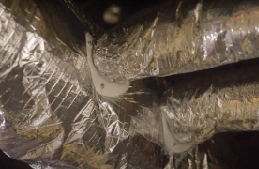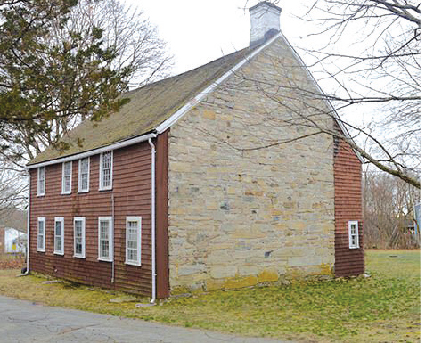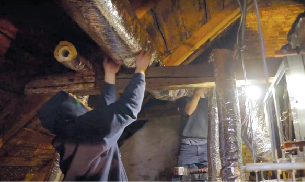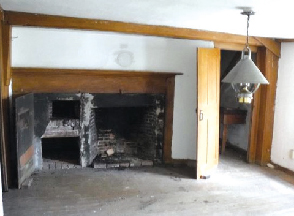Valentine Whitman House
Modernizing a Colonial-Era Home While Maintaining its History
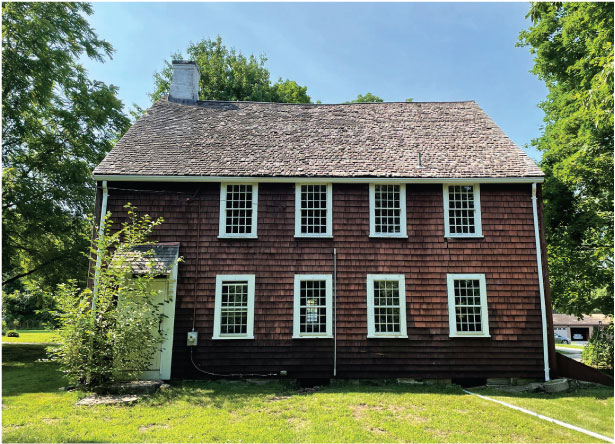
Colonists of 17-century Rhode Island faced many challenges adapting to their new environment but were able to use the area’s natural resources to their advantage when it came to homebuilding. Unlike most of New England, Rhode Island was abundant in the limestone used for mortar to build massive granite chimneys on the ends of houses. This architectural style, known as a “stone-ender”, was a vestige of British building. Fireplaces in stone-enders allow the rocks and mortar to absorb heat and radiate it throughout the rest of the timber structure, making these homes quite cozy in colder months. Well, “cozy” in colonial terms, meaning “not likely to freeze to death” but certainly not what we would consider comfortable.
Only a handful of stone-enders exist to this day, including the Valentine Whitman House in Lincoln, RI. In Valentine Whitman, Jr. built this stone-ender in 1694 along the Great Road in what was then still part of Providence proper. Considered rather large and elaborate for its time, the home featured tall timbers and was decorated with chamfers, a type of beveled corner. During its tenure the house survived an early 19th-century conversion into separate apartments and saw the surrounding farmland sold and developed into a subdivision in the 1950s. Around that time, with the threat of being lost to development, the home was documented by the Library of Congress’ “Historic American Buildings Survey.” Somehow, the home managed to survive until 1991 when it was rescued by the Town of Lincoln and operated as a museum for the next thirty years.
The Problem
In 2021, ownership of the home was transferred to the Preserve Rhode Island organization who, seeking to complete a full-scale rehabilitation of the structure, hired Rob Cagnetta and his team of craftspeople at Heritage Restoration in Providence. Rob, who holds an architectural degree from Roger Williams University, has over thirty years of experience in preserving and restoring historic structures. He and his team were given the daunting task of updating the home for modern living expectations while preserving as much of the home’s original design and finishing as possible.
How do you upgrade a 300-year-old home that has never had a central heating and air system for modern, 21st-century comfort without destroying the structure’s historic integrity? To answer that question, Rob turned to his old friend, Tim Cutler, of T.J.’s Plumbing & Heating outside of Boston, MA. When Tim first saw the Whitman home, he knew the only answer was The Unico System. Tim has been installing Unico in older and historic homes since he started in the business – in fact, some twenty years ago his installation in the 1796 Daniel Wheaton Home in Easton, MA was the subject of an earlier case study.
The Solution
Tim knew that the compact nature of The Unico System – it’s modular indoor equipment, main and supply ducting one-third the size of conventional systems – coupled with its advanced capabilities for producing efficient hydronic heat, was the only way to provide the house with up-to-date comfort while minimizing impact on the structure’s original design and aesthetics. Tim paired two Unico System air handlers equipped with ECM motors and hot water coils, one upstairs and one down, with two Bosch outdoor inverter heat pumps for cooling and a Viessman boiler for heating.
The Results
Notes Rob, “Believe it or not, the home has a very tight envelope considering that neither the walls nor attic are insulated – and can’t be to remain true to the home’s historic design. So, the fact that The Unico System operates on the principle of aspiration is of extreme importance.” In contrast to the “dump and throw” air delivery of typical forced air systems, aspiration gently mixes conditioned air with a room’s natural air currents resulting in even temperatures without drafts or hot or cold spots.
“Also of note,” adds Tim, “because The Unico System removes 30% more moisture in cooling mode than conventional HVAC systems it will help to preserve the original structural and finishing elements Rob’s team is uncovering during their restoration process.”
While Preserve Rhode Island has yet to determine what to do with the home once restoration is complete – potential plans include shortterm rental property, a private sale, or residential rental property – one thing is certain: future occupants may know what a home looked like in colonial times, but they’ll get to feel the experience while enjoying modern, superior comfort.
We’ll be checking in with Tim and Rob from time-to-time because both are so often involved with interesting projects. Additionally, Rob is filming all aspects of his “gentle touch of this major intervention” for a documentary on the project.
General Contractor
Rob Cagnetta Heritage Restoration 401-490-0888
Unico Installing Contractor
Tim Cutler TJ’s Plumbing & Heating, Inc.
Owner
Preserve Rhode Island
Location
Lincoln, Rhode Island
